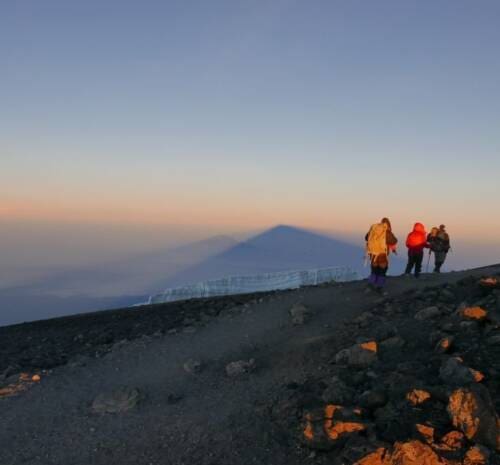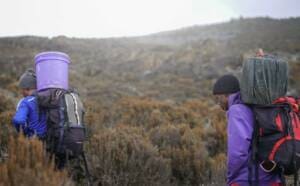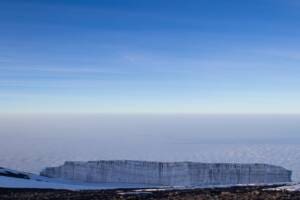Introduction
Is climbing Kilimanjaro hard
Is climbing Kilimanjaro hard: Is it challenging? In a word, yes! However, it’s also profoundly achievable with the right fitness level, a capable team, and a determined mindset.
Exploring the Challenges of Climbing Kilimanjaro: Beyond the Physical Strain. Climbing this iconic peak is a multifaceted endeavor, encompassing physical and mental challenges that must be conquered for a triumphant ascent.
1. Long hiking hours and Distance
The number of hours and distance walked on Kilimanjaro per day depends on the chosen route and itinerary. The seven routes up and down the mountain take between five and nine days. Their total length also varies from 53 km to 98 km (61 mi).
Kilimanjaro’s Shifting Challenges: From Short Hikes to Marathon Days. The journey’s diverse terrain and changing daily distances, like the eight-day Lemosho route’s contrasting treks, can surprise even seasoned climbers. The fitness level of your group also plays a pivotal role in determining your daily hiking hours.
Uphill Battles Without Respite: The Kilimanjaro Climb’s Relentless Nature. With no rest days and continuous uphill treks, climbing Kilimanjaro is a true test of strength and stamina, demanding unwavering determination throughout the week-long ascent.
2. Steep Climbing
Kilimanjaro is a mountain climb, so it goes without saying that you will be doing some serious climbing! Remember, your goal is to reach the summit, which is 5,895 meters above sea level!
Route Matters: Choosing Your Kilimanjaro Challenge. Kilimanjaro offers a variety of routes, each with its own unique challenges. From the steep and demanding Umbwe route to the longer but more gradual Northern Circuit, your choice of route can significantly impact your climbing experience.
Our Kilimanjaro Expert’s Steepness Rankings: Choosing the Right Challenge. When it comes to steepness, our leading Kilimanjaro expert has ranked the seven routes to help you make an informed choice:
- Umbwe: The shortest and steepest route, not for the faint of heart.
- Machame: A popular route with manageable steep sections and great scenery.
- Lemosho: Offers a more gradual ascent with stunning views.
- Rongai: Known for its gentler slopes and unique approach from the north.
- Marangu: The only route with huts, providing shelter along the way.
- Shira: Joins the Lemosho route, offering a challenging but rewarding journey.
- Northern Circuit: The longest and most gradual route, ideal for acclimatization.
Consider your fitness level and preferences when selecting the right route for your Kilimanjaro adventure
The Barranco wall is really steep
The Barranco Wall: A Climbing Challenge on Kilimanjaro. If you’re up for a climbing challenge on Kilimanjaro, the Barranco Wall is the ultimate test. This steep ascent requires some climbing skills and can be found on the Shira, Lemosho, Machame, and Umbwe routes.
However, if you’d rather avoid this steep climb, consider the Northern Circuit, Rongai, or Marangu routes. They offer a different experience with less verticality but still lead to Kilimanjaro’s majestic summit.

3. Height
Is climbing Kilimanjaro hard Vertical Challenge: Route Starting Heights. As you consider the height and visibility of Kilimanjaro during your ascent, it’s essential to note that each of the seven Kilimanjaro routes starts at a different elevation.
For instance, the Lemosho route and the Northern Circuit kick off at the Lemosho Gate, situated at a lofty 2,100 meters (6,890 ft) above sea level. On the other hand, the Marangu Gate, the starting point for the Marangu route, is notably lower at 1,843 meters (6,047 feet). This disparity in starting elevations means that the vertical journey to reach the summit of Uhuru Peak varies across routes, with Marangu presenting a more challenging ascent in terms of vertical distance.
Here is the elevation of the seven different routes in ascending order (ie from least to greatest rise):
- Shira route: 2,481 m (8,231 ft)
- Lemosho route: 3,795 m (12,541 ft)
- Northern Circuit: 3,795 m (12,541 ft)
- Rongai route: 3,945 m (13,033 ft)
- Marangu route: 4,052 m (13,384 ft)
- Machame route: 4,255 m (14,051 ft)
Vertical Challenges Unveiled: Kilimanjaro’s Ascent Variation. When it comes to conquering Kilimanjaro, the level of ascent required varies significantly between routes. The Machame route stands as the most demanding in terms of vertical gain, necessitating a formidable climb. In contrast, the Shira route offers a relatively gentler ascent, thanks to its higher starting point above the rainforest. Other routes, however, involve the double challenge of climbing upward and passing through the lush forested terrain.
While it might seem tempting to opt for routes with higher starting altitudes for a potentially easier ascent, there’s a crucial factor to consider: altitude sickness. The Shira route, despite its higher starting point, can pose a more significant risk of altitude-related issues due to its rapid ascent. So, it’s essential to weigh the trade-offs carefully when choosing your Kilimanjaro path.
4. Climb to extreme heights
Indeed, one of the most challenging aspects of climbing Kilimanjaro is the high altitude. As you ascend, the air becomes thinner, making it progressively harder to breathe due to reduced oxygen levels. This physical challenge is a significant part of the Kilimanjaro experience.
Facing reduced oxygen levels at higher altitudes can lead to discomforts like poor sleep, dizziness, nausea, and headaches. While these symptoms are common and not necessarily signs of illness, they can make the climb more challenging both physically and mentally. Climbing Kilimanjaro requires not only physical preparation but also mental fortitude to endure these discomforts.
Risk of altitude sickness
Although mild altitude sickness is common to almost all Kilimanjaro climbers, it is not a serious problem unless it develops into moderate or severe altitude sickness.
In cases of moderate to severe altitude sickness, immediate descent from the mountain is crucial, as it can be a life-threatening condition. Trust your guide’s judgment and prioritize your safety above all else when it comes to altitude-related issues.
We argue that this “uncertainty” makes climbing Kilimanjaro difficult because you have to plan your climb and accept that you may not complete it even if you have the necessary fitness and determination.
Is climbing Kilimanjaro hard, Altitude sickness doesn’t discriminate based on age, gender, or fitness level. It can affect anyone, seemingly striking at random and emphasizing the importance of proper acclimatization and precaution for all climbers.
The most effective defense against Is climbing Kilimanjaro hard, altitude sickness is a gradual ascent, allowing your body to adapt to the changing elevation. This is why we typically advise climbs lasting at least eight days, except for experienced high-altitude trekkers who are familiar with their body’s response to such conditions.
5. Extreme cold near the summit
Moving on to one of the most challenging aspects of Kilimanjaro: the extreme cold near the summit. Inadequate clothing and gear can put you at risk in these harsh conditions. That’s why it’s crucial to choose a reputable tour operator who can supply you with proper camping equipment and offer valuable advice on essential clothing and gear.
Yet, with the right gear, the biting cold at high altitudes adds to the challenge of climbing Kilimanjaro. Enduring freezing nights demands unwavering determination and mental focus. Prepare yourself for strong winds near the summit, as mental readiness is key to conquering these conditions.
7. Night Summit push at the top
Ascending Kilimanjaro often commences around midnight, a chilling experience. The team rouses you from slumber a tad earlier to prepare, offering solace in a steaming cup of hot beverage and cookies. Many opt to sleep in their outer layers, bracing themselves for this defining moment.
Most climbers discover they’ve scarcely slept when they rouse in the dead of night. The high altitude plays tricks on slumber, and jitters hardly grant respite. So, with just a few hours of fitful rest, you emerge into the inky cold, beginning the arduous ascent to Uhuru. The biting winds at this altitude intensify the ordeal, tempting you to huddle within your cocoon of a sleeping bag, while the summit’s siren call pushes you to persevere like never before!
Summit night on Kilimanjaro is an undeniable crucible for most climbers. Darkness shrouds the landscape, cold bites to the bone, thin air strains every breath, and the ascent spans a grueling thousand meters. It’s a monumental test, demanding both unwavering mental fortitude and peak physical condition. To conquer this formidable trial, one must steel themselves, nurturing both body and mind in preparation.
8. Camping and basic hygiene – Is climbing Kilimanjaro hard
Camping for over a week, except on the Marangu route with shared huts, means cozying up in tents and navigating through the camaraderie of fellow trekkers. Yet, the chief challenge often lies in maintaining hygiene. On Kilimanjaro, luxury showers aren’t on the menu; instead, you’ll have a handy bucket for strategic ‘wash wash’ sessions. Wet wipes stowed in your tent come to the rescue. And, of course, a trusty duo of deodorant and sanitizer should never be left behind.
What is the minimum age to climb Kilimanjaro? because Is climbing Kilimanjaro hard?
According to Kilimanjaro National Park rules, the minimum age to reach the summit is 10 years. We are careful about climbing with children under 15, as long hikes can be boring for them and the last few days can be dangerous. Please contact us if you feel your child under 15 is up to the challenge of Kilimanjaro so we can prepare for your child’s individual needs. to fight Is climbing Kilimanjaro hard
Can I climb Kilimanjaro on my own? It’s impossible!
Kilimanjaro National Park rules firmly dictate that trekking without an approved guide is a no-go for safety reasons. Climbing Kilimanjaro without a guide is technically possible, but it’s a challenging and daunting prospect. Most climbers opt for a well-prepared expedition with our experienced climbing team, and for good reason. Plus, attempting the climb solo would entail lugging all the essential equipment, making for a considerably longer and more strenuous journey!
Conclusion – Is climbing Kilimanjaro hard really difficult to climb?
Climbing Mount Kilimanjaro may be Is climbing Kilimanjaro hard an ambitious endeavor, but it’s a challenge well worth embracing. Conquering the summit of Africa demands meticulous planning, allocating ample time for acclimatization, and dedicated physical preparation.
While Africa’s tallest peak presents formidable challenges, it remains a conquerable feat.
Whether you aspire to conquer all seven summits or capture the ultimate selfie at Uhuru Peak, the journey begins with your first step in planning today!






